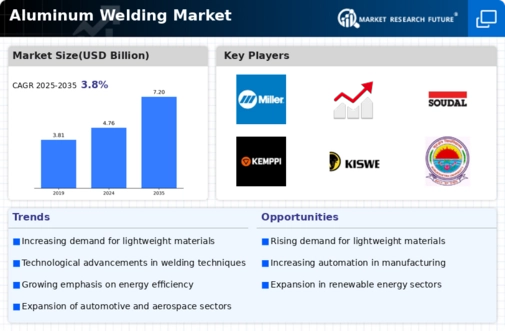Increased Focus on Research and Development
The Aluminum Welding Market is witnessing an increased focus on research and development (R&D) activities. Companies are investing in R&D to innovate and enhance welding techniques, materials, and processes. This emphasis on R&D is crucial for addressing challenges such as weld quality and efficiency. Recent data indicates that R&D expenditures in the welding sector are expected to rise by 10% annually, reflecting a commitment to advancing the Aluminum Welding Market. As new materials and technologies emerge, the industry is likely to evolve, offering improved solutions that cater to diverse applications and customer needs.
Technological Advancements in Welding Equipment
The Aluminum Welding Market is experiencing a surge in technological advancements, particularly in welding equipment and techniques. Innovations such as laser welding and robotic automation are enhancing precision and efficiency in aluminum welding processes. These advancements not only improve the quality of welds but also reduce production time and costs. According to recent data, the adoption of advanced welding technologies is projected to increase by 15% annually, indicating a robust growth trajectory for the Aluminum Welding Market. As manufacturers seek to optimize their operations, the integration of smart technologies and real-time monitoring systems is likely to become a standard practice, further driving the demand for advanced welding solutions.
Rising Demand in Automotive and Aerospace Sectors
The Aluminum Welding Market is significantly influenced by the rising demand in the automotive and aerospace sectors. As manufacturers increasingly utilize aluminum for its lightweight and corrosion-resistant properties, the need for effective welding solutions becomes paramount. The automotive sector alone is projected to account for over 40% of the total aluminum consumption by 2026, driven by the push for fuel-efficient vehicles. Similarly, the aerospace industry is expected to see a 20% increase in aluminum usage due to advancements in aircraft design. This growing demand necessitates innovative welding techniques, thereby propelling the Aluminum Welding Market forward.
Sustainability Initiatives and Eco-Friendly Practices
Sustainability initiatives are becoming increasingly pivotal within the Aluminum Welding Market. As industries strive to reduce their carbon footprints, the demand for eco-friendly welding practices is on the rise. The use of recyclable aluminum and energy-efficient welding processes aligns with global sustainability goals. Recent statistics suggest that companies adopting sustainable practices in their welding operations can reduce energy consumption by up to 30%. This shift not only meets regulatory requirements but also appeals to environmentally conscious consumers. Consequently, the Aluminum Welding Market is likely to witness a growing emphasis on sustainable practices, which could enhance brand reputation and customer loyalty.
Infrastructure Development and Construction Activities
Infrastructure development and construction activities are key drivers of the Aluminum Welding Market. With urbanization and population growth, there is a heightened need for robust infrastructure, including bridges, buildings, and transportation systems. Aluminum's lightweight and durable characteristics make it an ideal material for various construction applications. Recent reports indicate that the construction sector is expected to grow by 5% annually, leading to increased demand for aluminum welding solutions. This trend suggests that the Aluminum Welding Market will benefit from the ongoing investments in infrastructure, as companies seek reliable and efficient welding methods to meet project demands.





















Leave a Comment